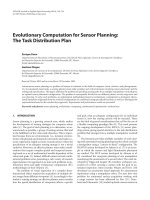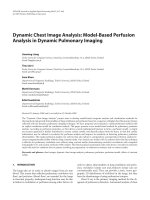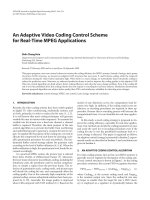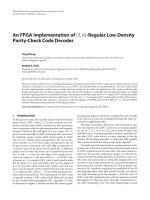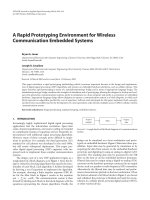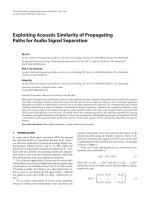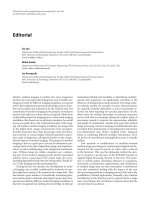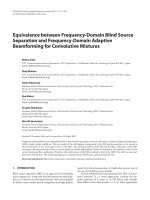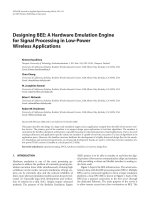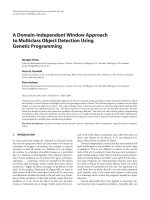EURASIP Journal on Applied Signal Processing 2003:8, 748–756 c 2003 Hindawi Publishing pptx
Bạn đang xem bản rút gọn của tài liệu. Xem và tải ngay bản đầy đủ của tài liệu tại đây (1.79 MB, 9 trang )
EURASIP Journal on Applied Signal Processing 2003:8, 748–756
c
2003 Hindawi Publishing Corporation
Evolutionary Computation for Sensor Planning:
The Task Distribution Plan
Enrique Dunn
Departamento de Electr
´
onica y Telecomunicaciones, Divisi
´
on de F
´
ısica Aplicada, Centro de Investigaci
´
on Cient
´
ıfica y
de Educaci
´
on Superior de Ensenada, 22860 Ensenada, BC, Mexico
Email:
Gustavo Olague
Depart amento de Ciencias de la Computaci
´
on, Divisi
´
on de F
´
ısica Aplicada, Centro de Investigaci
´
on Cient
´
ıfica y
de Educaci
´
on Superior de Ensenada, 22860 Ensenada, BC, Mexico
Email:
Received 29 June 2002 and in revised form 29 November 2002
Autonomous sensor planning is a problem of interest to scientists in the fields of computer vision, robotics, and photogramme-
try. In automated visual tasks, a sensing planner must make complex and critical decisions involving sensor placement and the
sensing task specification. This paper addresses the problem of specifying sensing tasks for a multiple manipulator workcell given
an optimal sensor placement configuration. The problem is conceptually divided in two different phases: activity assignment and
tour planning. To solve such problems, an optimization methodology based on evolutionary computation is developed. Opera-
tional limitations originated from the workcell configuration are considered using specialized heuristics as well as a floating-point
representation based on the random keys approach. Experiments and performance results are presented.
Keywords and phrases: sensor planning, evolutionary computing, combinatorial optimization, random keys.
1. INTRODUCTION
Sensor planning is a growing research area, which studies
the development of sensing strategies for computer vision
tasks [1]. The goal of such planning is to determine, as au-
tonomously as possible, a group of sensing actions that lead
to the fulfillment of the vision task objectives. This is impor-
tant because there are environments (i.e., dynamic environ-
ments with physical and temporal constraints) and tasks (i.e.,
scene exploration, highly accurate reconstruction) where the
specification of an adequate sensing strategy is not a trivial
endeavor. Moreover, an effective planner must make consid-
erations that require complex spatial and temporal reason-
ing based on a set of mathematical models dependent of the
vision task goals [2]. Indeed, difficult numerical and combi-
natorial problems arise, presenting a rich variety of research
opportunities. Our approach is to state such problems in op-
timization terms and apply evolutionary computation (EC)
methodologies in their solution [3].
The problem of visual inspection of a complex three-
dimensional object requires the acquisition of multiple ob-
ject images from different viewpoints [4]. Accordingly, to for-
mulate a sensing strategy, an effective planner must consider
how the spatial distribution of viewpoints affects a specific
task goal, what an adequate configuration for an individual
sensor is, how the sensing actions will be executed. These
are the kind of general considerations that call for the use of
a flexible computing paradigm like EC. This work presents
the ongoing development of the EPOCA [5] sensor plan-
ning system, giving special attention to the task distribution
problem that emerges from a multiple manipulator workcell
[6].
Theliteratureprovidesmultipleexamplesofworkdeal-
ing with automated sensing planning systems which consider
a manipulator using a “camera-in-hand” configuration. The
HEAVEN system developed by Sakane et al. [7] is an exam-
ple in which the camera and light illumination placement
are studied. The MVP system developed by Abrams et al.
[8] considered the viewpoint planning of one manipulator
monitoring the movements of a second robot. The work de-
veloped by Triggs and Laugier [9] considers workspace con-
straints of a robot carrying a camera with the goal of au-
tomated inspection. More recently, Whaite and Ferrie [10]
developed an uncertainty based approach for autonomous
exploration using a manipulator robot. The next best view
problem for automated surface acquisition working with
a range scanner has been addressed by Pito [11]. Marc-
hand and Chaumette [12] studied optimal camera motion in
Evolutionary Computation for Sensor Planning: The Task Distribution Plan 749
active vision systems for 3D reconstruction and exploration.
Ye and Tsotsos [13] developed a sensor planner system for 3D
object search applied in mobile robotics. However, none of
these systems have studied the problem of assigning and se-
quencing the best order of movements that a multiple robot
system needs to perform.
This paper is organized as follows. First, the problem
statement is given in Section 2. Then, our approach to the
task distribution problem using EC is presented in Section 3.
In this sec tion, we address the aspects of search space reduc-
tion, solution representation, and search heuristics. Experi-
mental results are presented next in order to demonstrate the
validity and usefulness of the solution. Finally, conclusions
and guidelines for future research are provided to end the
paper.
2. PROBLEM STATEMENT
The automation of visual inspection tasks can be achieved
with the use of manipulator robots, see Figure 1.How-
ever, the incorporation of such devices makes additional de-
mands on a sensing planner. In this example, each cam-
era is mounted on the robot hand with the goal of mea-
suring the box on the table. Also, a dditional floating cam-
eras represent a set of desired viewpoints. The sensing plan
must consider not only the constraints and objectives of the
particular visual task but also the operational restrictions
imposed by the workcell. Additionally, in the case where
multiple manipulators are equipped with digital cameras, a
problem of robot coordination needs to be resolved. More
precisely, sensing actions need to be distributed among the
various sensing stations, and an efficient task specification
for the entire workcell should be determined. The EPOCA
network design module can determine an optimal sensing
configuration for multiple cameras converging on a three-
dimensional object [14]. We use this configuration as input
for our task distribution problem in the proposed multiple
robot workcell. It is assumed that the robots move in straight
lines between different viewpoints and that each robot must
start and finish each tour from a predetermined configura-
tion. In this way, the problem of specifying an efficient task
distribution for the manipulator robots consists of the fol-
lowing.
(1) Assigning to each of the robots a set of viewpoints from
which to obtain an image, see Figure 2. In other words,
determining how many and which viewpoints are to be
assigned to each robot.
(2) Deciding on an optimal tour for each of the robots, see
Figure 3. This involves specifying the correct order of
each viewpoint in a robot’s tour.
In this way, we have two of the most difficult combinato-
rial problems in computer science, which are the set parti-
tion and traveling salesman problems, see Figures 2 and 3
for the graphical interpretation of these problems. Actually,
our task distribution problem consists of a multiple traveling
salesman problem instance. The goal is to specify the optimal
Figure 1: Photogrammetric network simulation of four robots.
Figure 2: Activity assignment. Each viewpoint is assigned to one of
the robots, forming different excluding sets.
Figure 3: Tour planning. Each of the sets is ordered, specifying the
tour to follow each of the robots.
combination of multiple subtours, with the requirement that
every viewpoint specified by the EPOCA network configura-
tion module is visited. In order to describe our task distribu-
tion problem, the following definitions are given.
750 EURASIP Journal on Applied Signal Processing
Definition 1 (Photogrammetric network). A photogram-
metric network is represented as an ordered set V of n three-
dimensional viewpoints. Each individual viewpoint is ex-
pressed as V
j
,wherej ranges from j = 1ton.
Definition 2 (Robot workcell). A multirobot active vision
system is represented by an ordered set R consisting of r
robots in the workcell. Each indiv idual robot is expressed by
R
i
,wherei ranges from i = 1tor.
Definition 3 (Operational environment). Each robot has an
operational restricted physical space denoted by O
i
,wherei
ranges from i = 1tor.
Accordingly, the problem statement can be expressed as
follows.
Definition 4 (Task distribution problem). Find a set of r or-
dered subsets X
i
⊆ V,whereV ={∪
r
i=1
X
i
| V
j
∈ X
i
,V
j
∈
O
i
} such that the total length traveled by the robots is mini-
mized.
From the above definitions, the activity assignment prob-
lem relates each of the n elements of V with one of the
r possible elements of R. Considering that each robot R
i
has assigned n
i
viewpoints, a problem of sequencing the
viewpoints emerges, which we call tour planning. Our goal is
to find the best combination of activity assignment and tour
planning in order to optimize the overall operational cost
of the task distribution. This total operational cost is pro-
duced by adding individual tour costs, Q
i
, defined by the Eu-
clidean distance that each robot needs to travel in straight
lines among the different viewpoints. Hence, the criterion
is represented as Q
T
=
r
i=1
Q
i
. Such a problem statement
yields a combinatorial problem which is computationally
NP-hard and requires the use of special heuristics in order
to avoid an exhaustive search.
3. EC APPROACH TO TASK DISTRIBUTION
Our problem is presented as a combinatorial optimization
problem with a large search space. An optimization method
based on genetic algorithms is proposed. To obtain a quality
solution, three key aspects need to be addressed: search space
reduction, solution representation,andsearch heuristics.The
following sections present our approach to these key aspects
in order to develop a global optimization method to s olve the
task distribution problem.
3.1. Search space reduction
Combinatorial problems generally have to satisfy a given set
of competing restrictions. In our task distribution problem,
some of these restrictions are straightforward; that is, each
viewpoint should be assigned to only one robot, each view-
point should be visited only once inside a robot tour. On
the other hand, implicit restrictions, like the accessibility of a
robot to a particular viewpoint, need to be determined. Con-
sideration of such restrictions can help reduce the size of the
search space. This is relevant because in practice a manip-
Figure 4: Operational restrictions. The workcell configuration im-
poses accessibility restrictions. Hence, when a robot reach is limited,
it is possible to reduce the search space for the activity assignment
phase.
Table 1: Structure ACCESSIBILITY containing the number and the
list of robots capable of reaching a particular viewpoint.
Viewpoint ID Number of robots List of robots ID’s
V
1
r
1
RobID
1
, ,RobIDr
1
.
.
.
.
.
.
.
.
.
V
n
r
n
RobID
1
, ,RobIDr
n
ulator has limited workspace, see Figure 4. The method by
which such restrictions are computed is presented next.
Assuming a static and obstacle-free environment, it is
reasonable to compute the robots accessibility for a given po-
sition and orientation by means of solving the robot inverse
kinematic problem. In this work, we consider the PUMA560
manipulator which consists of six degrees of freedom. A
three-dimensional computer graphics simulation environ-
ment was developed in order to visualize such accessibility
restrictions. Multiple manipulators were considered in our
computer simulation. The inverse kinematic problem was
solved for every robot at each viewpoint. The cases where a
robot could access a viewpoint were stored in an auxiliary
data structure called ACCESSIBILITY. This structure con-
tains an entry for every viewpoint V
j
in order to keep a
record of how many and which robots are capable of reach-
ing that particular v iewpoint, see Table 1. Such values remain
constant throughout the course of task execution, therefore,
they only need to be computed once. The above method eval-
uates the restrictions imposed by the physical arrangement
of the workcell, as well as the robot revolute joint limitations.
Such operational restrictions are incorporated implicitly as
an intrinsic element of our optimization method.
3.2. Solution representation
A representation similar to random keys [15]isproposed.
In this representation, each viewpoint V
j
is assigned a ran-
dom value S
j
in the range (0, 1), allowing for the imple-
mentation of very straightforward genetic operators. These
Evolutionary Computation for Sensor Planning: The Task Distribution Plan 751
S =
0.41 0.51 0.15 0.79 0.63 0.96 0.84 0.18
S
1
S
2
S
3
··· S
n
Figure 5: Solution encoding. Each of the n viewpoints is assigned a
random floating-point value S
i
in the range (0, 1). These values are
stored in a string S.
values are stored in a representation string denoted by S.
Since there are n different viewpoints, S will consist of n ele-
ments, see Figure 5. Random keys use a heuristic we call the
smallest-value-first heuristic. In our case, the viewpoint with
the smallest corresponding value in S would be the first view-
point in a given permutation P. The viewpoint with the sec-
ond smallest value in S would be the second viewpoint in P,
and so forth. In this way, the order of a viewpoint V
j
inside
agivenpermutationP depends on the magnitude of its cor-
responding value S
j
with respect to all the other values in S.
To illustrate, given five viewpoints, a possible representation
string can be
S = [0.89, 0.76, 0.54, 0.23, 0.62]. (1)
The smallest value in S is found at the fourth position, de-
noted by S
4
. Therefore, V
4
is the first viewpoint in the result-
ing permutation P. T he second smallest value is found in the
third position S
3
, making V
3
the second viewpoint in P,and
so on. The resulting permutation of the five viewpoints is
P =
V
4
,V
3
,V
5
,V
2
,V
1
. (2)
Therandomkeysapproachcanbeadaptedtosolveour
task distribution problem. The smallest-value-first heuris-
tic avoids the generation of unfeasible solutions common to
permutation-based representations. Random keys represen-
tation also allows our optimization method to apply genetic
operators without the need for additional heuristics.
The convention of encoding a possible solution into a
string representation has been specified. The question of how
to describe the corresponding solution to such a represen-
tation is now considered. Recalling the problem statement,
initially, there is a set of n viewpoints V
j
,andeachmustbe
assigned to one of the r possible robots. Using random keys
representation, a possible solution is codified into a string S
of n values. As stated in Section 2, we want to optimize the
total operational cost Q
T
. However, the solution representa-
tion S needs to be decoded into an explicit description of the
task distribution problem. Such a description would repre-
sent each of the r robot tours. To accomplish this, an aux-
iliary data structure called TASKS is proposed to represent
the global task distribution among robots, see Table 2. This
structure has an entry T
i
for each robot R
i
, which describes
that robot tour; that is, T
i
lists the sequence of viewpoints
assigned to that particular robot. Each of these T
i
tours is
evaluated to obtain an individual tour cost Q
i
,fromwhich
the total operational cost Q
T
is obtained. The question be-
fore us now is how to convert a string representation into a
corresponding task distribution description. The following
Table 2: Structure TASKS containing the list of viewpoints com-
prising each robot tour T
i
.
Robot ID Number of viewpoints List of viewpoint ID’s
R
1
v
1
T
1
= [ViewID
1
, ,ViewIDv
1
]
.
.
.
.
.
.
.
.
.
R
r
v
r
T
r
= [ViewID
1
, ,ViewIDv
r
]
subsection presents the heuristics used by our method to ob-
tain such task distribution description.
3.3. Search heuristics
A solution representation S needs to be evaluated. Such eval-
uation is applied to the task distribution description con-
tained in TASKS. Hence, a mapping M : S → TASKS is
necessary. The mapping M assigns and sequences the view-
points among the different robots and stores the results in
the structure TASKS. The mapping M makes use of the so-
lution representation data structures S andTASKS,aswellas
the precomputed operational restrictions stored in ACCES-
SIBILITY. The two distinct phases of a ctivity assignment and
tour planning are presented separately.
3.3.1 Activity assignment
The activity assignment problem allocates each of the view-
points V
j
to one of the possible robots. The goal is to provide
an initial unsequenced set of individual robot tours T
i
using
the following steps.
Step 1. Obtain the r
j
number of robots capable of reaching
that particular viewpoint by consulting the ACCESSI-
BILITY st ructure, see Table 1 .
Step 2. Divide the interval (0, 1) into r
j
equally distributed
segments in order to determine the size of a compari-
son segment Seg = 1/r
j
.
Step 3. Calculate in which k segment the random value S
j
re-
sides, that is, k = Int(S
j
/ Seg) + 1.
Step 4. Assign the viewpoint V
j
to the kth robot in the cor-
responding entry in the ACCESSIBILITY structure. In
this way, the assigned robot index i is given by RobID
k
,
which is found on the entry that corresponds to V
j
in-
side the ACCESSIBILITY table.
Step 5.AppendV
j
to the list of viewpoints, T
i
assigned to
the ith robot. The tour description T
i
is stored in the
TASKS structure.
A graphical descr iption of these heuristic steps is shown
in Figure 6. The series of actions performed in the activity
assignment phase are based on the compliance with opera-
tional restrictions, and in doing so, assure that any codified
string S brings a valid solution to the assignment problem.
Based on such strategy, each possible codification string S has
only one possible interpretation. After executing this series of
steps, each viewpoint is assigned to a robot. The v iewpoints
assigned to a single robot R
i
are grouped into a set T
i
.Each
752 EURASIP Journal on Applied Signal Processing
S = 0.41 0.23 0.15 0.79 0.42 0.96 0.64 0.18
S
1
S
2
S
3
···
S
n
ACCESSIBILITY
Viewpoint
Number of
robots
List of
robots
V
1
···
V
n
3
···
r
n
R
1
,R
3
,R
4
···
RobID
1
, ,RobID
rn
1
2
3
4
k = 2
01/32/31
Figure 6: Activity assignment heuristics. The diagram shows Steps
1 through 4, corresponding to the assignment phase.
T
i
represents a tour of viewpoints assigned to that particular
robot and these tours are stored in the structure TASKS. Un-
til this point, the order of each viewpoint inside a given tour
has not been specified. This is the problem we approach next.
3.3.2 Tour planning
The tour planning problem consists of correctly sequencing
each of the r robot tours T
i
stored in the structure TASKS.
These tours are initially obtained from the activity assign-
ment phase presented above, in which every viewpoint V
j
is
assigned to one of the r possible robots R
i
. The goal of the
tour planning phase is to minimize the total operational cost
Q
T
. This situation is equivalent to solving r different travel-
ing salesman problems. The smal lest-value-first heuristic can
be applied to sequencing problems such as the one presented
here. Unfortunately, the rules by which the preceding assign-
ments were made in Steps 1 through 4 produce undesirable
tendencies in the representation values S
j
that correspond to
each tour specification T
i
. This is due to the deterministic
heuristic applied for robot assignment. As a consequence, the
values corresponding to the viewpoints contained in T
i
will
be, on the average, higher than those corresponding to the
viewpoints in T
i−1
and will create a bias inside each T
i
when
directly applying the smallest-value-first heuristic. Therefore,
the values inside S need to be adjusted to eliminate such
unwanted properties. This is accomplished by the following
heuristic steps.
Step 6. Recall in which of the k possible segments of the range
(0, 1) lies the S
j
value used in the assignment phase.
Step 7. Calculate the value S
j
in the range (0, 1) that reflects
the relative position of S
j
inside the kth segment. For
example, consider the value 0.70 which lies inside the
range (0.60, 0.80). This value lies exactly in the middle,
hence its corresponding value in the range (0, 1) is 0.5.
A graphic description of this heuristic is presented in
Figure 7.
S = 0.41 0.23 0.15 0.79 0.42 0.96 0.64 0.18
S
1
S
2
S
3
···
S
n
S
1
= 0.41
0
1/3 2/3
1
1/3 2/3
S
1
= 0.24
Mapping
01
Figure 7: Mapping of the representation string values. Each of the
values contained in S is adjusted before applying the smallest-value-
first heuristic to the values stored in TASKS.
TASKS
Robot ID No. of views List of viewpoints
R
1
3 T
1
= [V
1
,V
3
,V
8
]
.
.
.
.
.
.
.
.
.
R
m
r
m
T
m
= [ViewID
1
, ,ViewIDr
m
]
S = 0.24 0.73 0.04 0.34 0.77 0.69 0.27 0.46
S
1
S
2
S
3
···
S
8
Applying the smallest-value-first heuristic the list
T
1
is rearranged in the following manner
Robot ID No. of views List of viewpoints
R
1
3 T
1
= [V
3
,V
1
,V
8
]
Figure 8: Tour planning. The smallest-value-first heuristic is ap-
plied to each robot tour considering the previously adjusted values
in S.
Step 8. Update S
j
to store the new value S
j
.
Step 9. Apply the smallest-value-first heuristic to each of the
unordered robot tours T
i
using the values stored in S
,
see Figure 8.
These series of steps ensure an unbiased tour sequenc-
ing, hence, empowering the search algorithm to more effec-
tively seek out a global optima from a very large and complex
search space.
4. EXPERIMENTATION AND RESULTS
The solution presented in the previous sections for the task
distribution problem was incorporated into an extension of
the functionality of the EPOCA system developed by Olague
Evolutionary Computation for Sensor Planning: The Task Distribution Plan 753
[5]. EPOCA solves the photogr ammetric network design
problem for complex objects. The problem of task distri-
bution emerges as a result of the photogrammetric network
design performed by EPOCA. The system can be classified
as an EC-based system that addresses the complex goal of
automating the planning of sensing strategies for accurate
three-dimensional reconstruction.
Two different experiments are presented next: the first is
a simple scenario intended to illustrate our method’s func-
tionality; the second experiment is somewhat more complex
and its goal is to show the effectiveness and flexibility of our
system.
4.1. Experiment A
This experiment consists of eight viewpoints to be dis-
tributed among four manipulators. The viewpoints are
stacked into four pairs, each pair arranged beneath one of
the robots initial position, see Figure 9. The optimal task dis-
tribution for this example can be obtained using a greedy
heuristic. Hence, such an experiment might seem trivial, but
it will exemplify our method’s functionality.
Operational restrictions are computed first, with the
goal of determining which robots can access a particular
viewpoint. As mentioned in Section 3,tocomputesuchre-
strictions, the inverse kinematic problem is solved for ev-
ery robot at each viewpoint. The results of such validations
are stored in the structure ACCESSIBILITY. The physical
arrangement of the robots for Experiment A is such that
every camera can be reached by three different robots, see
Table 3.
The genetic algorithm works with a population of codi-
fied strings, selecting the best individuals for reproduction.
Such reproduction process combines the characteristics of
two selected parent solutions and provides two new offspring
solutions which, in turn, will be part of the next generation
of solutions. This process is repeated in an iterative manner
until a certain number of generations is executed. At the end
of this iterative process, we obtain a set of possible solutions.
One of those individuals, which represented the optimal so-
lution, was given by the following random keys representa-
tion:
S = [0.72, 0.71, 0.32, 0.14, 0.81, 0.80, 0.27, 0.07]. (3)
After the assignment heuristic, we determine in which of
the k segments each element S
j
resides. For the first view-
point V
1
, there are three possible robots to be assigned, see
Table 3; hence, the comparison segment Seg = 1/3 = 0.33.
In this way, following Steps 1 through 5, the corresponding
representation value S
1
= 0.72 is determined to be in the
third segment, which is delimited by (0.66, 1.00). Therefore,
the robot to be assigned is the third robot on V
1
’s entry on
the str ucture ACCESSIBILITY, in this case RobID = 3. The
corresponding robot to be assigned to each viewpoint V
j
is
given by
Robot
=
R
3
,R
3
,R
1
,R
1
,R
4
,R
4
,R
2
,R
2
. (4)
Figure 9: Eight viewpoints are to be distributed among four ma-
nipulators. Viewpoints are depicted as individual cameras and solid
lines connected such cameras illustrate each robot tour correspond-
ing to an optimal task distribution.
Table 3: ACCESSIBILITY restrictions calculated for Experiment A,
depicted in Figure 9.
Viewpoint ID Number of robots List of robots ID’s
V
1
r
1
= 3 R
1
R
2
R
3
V
2
r
2
= 3 R
1
R
2
R
3
V
3
r
3
= 3 R
1
R
3
R
4
V
4
r
4
= 3 R
1
R
3
R
4
V
5
r
5
= 3 R
1
R
2
R
4
V
6
r
6
= 3 R
1
R
2
R
4
V
7
r
7
= 3 R
2
R
3
R
4
V
8
r
8
= 3 R
2
R
3
R
4
At this point, we have an appropriately assigned set of
viewpoints. The values contained in S will now be adjusted
in accordance with Steps 5 through 9 so that the smallest-
value-first heuristic can be applied to the viewpoints assigned
to each robot. For the first viewpoint, its corresponding value
S
1
is adjusted as follows. Recall that S
1
= 0.72 resides on the
third segment which is delimited by (0.66, 1.00). The corre-
sponding value of 0.72 on the range (0, 1) with respect to the
third segment just mentioned is given by the value 0.18. Ap-
plying these steps to every value in S yields
S
= [0.18, 0.15, 0.96, 0.42, 0.45, 0.42, 0.81, 0.21]. (5)
Once the values in S have been adjusted, applying the
smallest-value-first heuristic rearranges TASKS as shown in
Table 4.
Twenty trials were executed and this global minimum
distribution was reached in every single execution in an av-
erage of 15.1 generations.
4.2. Experiment B
This experiment presents a complex planar object which is
measured by four manipulators. The goal is to distribute the
754 EURASIP Journal on Applied Signal Processing
Table 4: TASKS for an optimal solution in Experiment A after the
tour planning phase.
Robot ID Number of viewpoints List of viewpoint ID’s
12 T
1
= [V
4
V
3
]
22 T
2
= [V
8
V
7
]
32 T
3
= [V
2
V
1
]
42 T
4
= [V
6
V
5
]
Figure 10: Thirteen viewpoints are to be distributed among four
manipulators. Viewpoints are depicted as individual cameras.
Figure 11: Best solution found by the genetic algorithm for the con-
figuration shown in Figure 10.
photogrammetric network consisting of 13 cameras in an op-
timal manner, see Figure 10. Working with this fixed config-
uration, we executed several tests. First, to test our method’s
functionality, we executed the task distribution planner. Sev-
eral possible solutions are obtained over the course of multi-
ple executions, two of such solutions are depicted in Figures
11 and 12. Notice that the best solution found, represented
in Figure 11, does not incorporate all of the available robots.
Figure 12 shows a more typical solution which is also found
by our system.
In order to test the method’s adaptability, two of the four
manipulator robots were disabled. This additional restriction
is reflected only on changes to the values stored in Table 5.
Figure 12: Another solution found by the system that corresponds
to the configuration shown in Figure 10.
Table 5: ACCESSIBILITY restrictions calculated for Experiment B,
depicted in Figure 10.
Viewpoint ID Number of robots List of robots ID’s
V
1
r
1
= 2 R
2
,R
4
V
2
r
2
= 2 R
2
,R
3
V
3
r
3
= 2 R
1
,R
4
V
4
r
4
= 2 R
1
,R
4
V
5
r
5
= 2 R
1
,R
4
V
6
r
6
= 2 R
2
,R
3
V
7
r
7
= 2 R
2
,R
4
V
8
r
8
= 2 R
2
,R
3
V
9
r
9
= 2 R
1
,R
3
V
10
r
10
= 2 R
1
,R
3
V
11
r
11
= 3 R
1
,R
2
,R
3
V
12
r
12
= 3 R
1
,R
2
,R
4
V
13
r
13
= 3 R
1
,R
2
,R
4
The system is expected to distribute tasks among the two re-
maining robots. Results from such tests are show n in Figures
13 and 14. In these cases the activity assignment problem be-
comes visually more simple to resolve, but the difficulty of
the tour planning problem becomes more evident since each
tour will consist of more viewpoints.
Since our approach is based on EC techniques, the de-
termination of the task distribution plan is the product of
the evolution process over a population of possible solutions.
Therefore, fitness values of each of these individuals, and of
the population in general, reflect the effect of such evolu-
tion. In this way, the population fitness values evolve over
the course of several generations until an optimal solution
is found, see Figure 15. The stepwise decrements in the best
fitness line point out the combinatorial aspect of our search,
while the average fitness confirms the positive effect of the
evolution process.
While great detail has been given to the special heuristics
used in our approach, the behavior of the curves presented in
Evolutionary Computation for Sensor Planning: The Task Distribution Plan 755
Figure 13: Solution found by the system for the case where a pair
of robots were disabled from the configuration shown in Figure 10.
Figure 14: An environment similar to Figure 13 showing the sys-
tem’s fl exibility to changes in the workcell configuration.
Generation
20 40 60 80 100 120
Operational cost in mm.
1000
1500
2000
2500
3000
3500
4000
4500
5000
5500
Best
fitness
Average
fitness
Wors e
fitness
Figure 15: Population fitness over the evolution process.
Figure 15 and the overall performance depend on the genetic
algorithm operational parameters. A single point crossover
operator, subject to a probability P
c
= 0.95, was utilized.
Furthermore, the mutation operator consisting of an addi-
tive value obeying a normal distribution N(0, 0.2) for each
of the elements in the representation string was also applied
according to a probability P
m
= 0.001.
Execution number
10 20 30 40 50
Operational cost in mm.
1720
1760
1800
1840
1880
1920
1960
Gready
search
Exhaustive
search
Figure 16: Genetic algorithm performance over multiple execu-
tions. The obtained solutions are always better than a greedy search,
reaching the global optima 14 out of 50 times.
An appreciation of the effectiveness of the proposed
methodology is obtained from the comparison of its solu-
tions against those offered by alternative methodologies. T he
proposed methodology is compared to an exhaustive search
and a greedy heuristic. The results for the fixed configura-
tion shown in Figure 10 are presented in Figure 16. As the
figure illustrates, our algorithm consistently outperforms a
greedy heuristic in terms of the quality of the proposed solu-
tions. The advantage obtained with the genetic algorithm ap-
proach refers to the computational cost; considering the EC
algorithm requires about 3 seconds against 14 hours for an
exhaustive search. On the other hand, our approach reaches
a global optima 28% of the time over the course of 50 execu-
tions, coming within an average of 2.9% to global optima. As
these results reflect, there is an obvious compromise between
solution quality and computational efficiency.
5. CONCLUSIONS AND FUTURE WORK
The development of an effective sensor planner for auto-
mated vision tasks implies the consideration of oper a tional
restrictions as well as the vision tasks objectives. This work
presents a solution for the task distribution problem inher-
ent to multiple robot workcells. The problem is conceptual-
ized as two separate combinatorial problems: activity assign-
ment and tour planning. A genetic algorithm-based strategy
that concurrently solves these problems was presented along
with experimental results. The approach employs a uxiliary
data structures in order to incorporate accessibility limita-
tions and to specify a task distribution plan. The evolutionary
nature of the optimization method allows for multiple ap-
proximate solutions of the optimization problem to be found
over the course of several executions. Performance consider-
ations support the use of the proposed methodology com-
pared to a greedy heuristic or an exhaustive search.
Future work can consider the robot motion planning
problem presented when there are obstacles in the environ-
ment or when the manipulator can collide with each other.
Also, the representation scheme can be modified to use two
values instead of adjusting the original representation string
by heuristic means. Furthermore, the genetic operators can
756 EURASIP Journal on Applied Signal Processing
be modified in search of improving the evolutionary algo-
rithm performance. Also, a rigorous analysis of the proper-
ties of the heuristics used is needed. At present, we are work-
ing toward a real implementation of our algorithms for intel-
ligent sensor planning.
ACKNOWLEDGMENTS
This research was founded by Contract 35267-A from
CONACyT and under the LAFMI Project. The first author
was supported by scholarship 142987 from CONACyT. Fig-
ures 1, 2, 3, 4, 9, 10, 11, 12, 13,and14 were generated with
software written at the Geometry Center. The authors thank
the anonymous reviewers for their suggestions which greatly
helped improve this paper.
REFERENCES
[1] K.A.Tarabanis,P.K.Allen,andR.Y.Tsai,“Asurveyofsensor
planning in computer vision,” IEEE Transactions on Robotics
and Automation, vol. 11, no. 1, pp. 86–104, 1995.
[2] J. Miura and K. Ikeuchi, “Task-oriented generation of visual
sensing strategies in assembly tasks,” IEEE Trans. on Pattern
Analysis and Machine Intelligence, vol. 20, no. 2, pp. 126–138,
1998.
[3] G. Olague and R. Mohr, “Optimal camera placement for ac-
curate reconstruction,” Pattern Recognition,vol.35,no.4,pp.
927–944, 2002.
[4] T.S.NewmanandA.K.Jain, “Asurveyofautomatedvisual
inspection,” Computer Vision and Image Understanding,vol.
61, no. 2, pp. 231–262, 1995.
[5] G. Olague, Planification du placement de cam
´
eras pour des
mesures 3D de pr
´
ecision, Ph.D. thesis, Institut National Poly-
technique de Grenoble, France, October 1998.
[6] G. Olague and E. Dunn, “Multiple robot task distribution:
Towards an autonomous photogrammetric system,” in Proc.
IEEE Systems, Man and Cybernetics Conference,vol.5,pp.
3235–3240, Tucson, Ariz, USA, October 2001.
[7] S. Sakane, R. Niepold, T. Sato, and Y. Shirai, “Illumination
setup planning for a hand-eye system based on an environ-
mental model,” Advanced Robotics, vol. 6, no. 4, pp. 461–482,
1992.
[8] S. Abrams, P. K. Allen, and K. A. Tarabanis, “Dynamic sensor
planning,” in Proc. IEEE International Conf. on Robotics and
Automation, Atlanta, Ga, USA, May 1993.
[9] B. Triggs and C. Laugier, “Automatic task planning for robot
vision,” in Proc.Int.Symp.RoboticsResearch, Munich, October
1995.
[10] P. Whaite and F. P. Ferrie, “Autonomous exploration: Driven
by uncertainty,” IEEE Trans. on Pattern Analysis and Machine
Intelligence, vol. 19, no. 3, pp. 193–205, 1997.
[11] R. Pito, “A solution to the next best view problem for auto-
mated surface acquisition,” IEEE Trans. on Pattern Analysis
and Machine Intelligence, vol. 21, no. 10, pp. 1016–1030, 1999.
[12] E. Marchand and F. Chaumette, “Active vision for complete
scene reconstruction and exploration,” IEEE Trans. on Pattern
Analysis and Machine Intelligence, vol. 21, no. 1, pp. 65–72,
1999.
[13] Y. Ye and J. K. Tsotsos, “Sensor planning for 3D object search,”
Computer Vision and Image Understanding,vol.73,no.2,pp.
145–168, 1999.
[14] G. Olague, “Automated photogrammetric network design us-
ing genetic algorithms,” Photogrammetric Engineering & Re-
mote Sensing, vol. 68, no. 5, pp. 423–431, 2002, Paper awarded
the “2003 First Honorable Mention for the Talbert Abrams
Award”, by ASPRS.
[15] J. C. Bean, “Genetic algorithms and random keys for sequenc-
ing and optimization,” ORSA Journal on Computing,vol.6,
no. 2, pp. 154–160, 1994.
Enrique Dunn received a computer en-
gineering degree from Universidad Au-
t
´
onoma de Baja California, in 1999. He ob-
tained the M.S. degree in computer science
from CICESE, Mexico, in 2001. Currently,
Dunn is working towards the Ph.D. degree
at the Electronics and Telecommunications
Department, Applied Physics Division, CI-
CESE, Mexico. His research interests in-
clude robotics, combinatorial optimization,
evolutionary computation, close range photogrammetry, and 3D
simulation. He is a student member of the ASPRS.
Gustavo Olague holds a Bachelor’s degree
(Honors) in Electronics Engineering and a
Master’s degree in computer science from
the Instituto Tecnol
´
ogico de Chihuahua,
Mexico, in 1992 and 1995, respectively. He
received the “Dipl
ˆ
ome de Doctorat en Im-
agerie, Vision et Robotique” (Ph.D.) from
Institut National Polytechnique de Greno-
ble, France, in 1998. From 1999 to 2001, he
was an Associate Professor of computer sci-
ence and in 2002, he was promoted to Professor of the Applied
Physics Division at CICESE, Mexico. Dr. Olague is a member of
the ASPRS, ISGEC, IEEE, IEEE Computer Society, IEEE Robotics
and Automation, IEEE SMC and RSPSoc. Dr. Olague has served on
numerous Technical Committees and has b een invited to lecture at
universities in France, Spain, and Colombia. He has served as Chair
and Cochair at numerous international conferences like the ASPRS
2001 and 2003 during the Close-Range Photogrammetry session
and the IEEE SMC 2001 Robotics session. He also had visiting ap-
pointments at the Technische Universit
¨
at Clausthal, Germany and
the LAAS, France. His research interests include robotics, computer
vision, and, in particular, the coupling of evolutionary computa-
tion in those two research domains (autonomous systems and vi-
sual perception). Dr. Olague is recipient of the 2003 First Honor-
able Mention for the Talbert Abrams Award.
